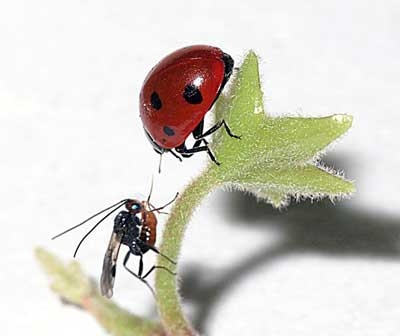It is as astonishing as it is sad to watch a ladybug turn into a zombie.
Normally ladybugs are sophisticated and voracious predators. A single individual may devour several thousand aphids in a lifetime.
To find a victim, it first waves its antennae to detect chemicals that plants release when they're under attack by herbivorous insects. Once it has homed in on these signals, the ladybug switches its sensory scan to search for molecules released only by aphids. Then it creeps up and strikes, ripping the aphid apart with barbed mandibles.
Ladybugs are also well protected against most of their enemies. Their red-and-black dome, so adorable to the human eye, is actually a warning to would-be predators: You will regret this.
When a bird or some other animal tries to attack, the ladybug bleeds poison from its leg joints. The attacker tastes the bitter blood and spits the ladybug out.
Predators learn to read the red-and-black wing covers as a message to stay away.
A predator protected from other predators, the ladybug would seem to have the perfect insect life—were it not for wasps that lay their eggs inside its living body.
Egg injection
One of these wasps, Dinocampus coccinellae, is about the size of an ice-cream sprinkle.
When a female wasp is ready to lay an egg, she alights near a ladybug and swiftly inserts her stinger into its underside, injecting an egg into her victim along with a blend of chemicals.
When the egg hatches, the larva feeds on the fluids that fill its host's body cavity.
Though the ladybug is gradually being devoured, on the outside it seems unchanged.
It goes on attacking aphids with abandon. But after it has digested its prey, its parasite feeds and grows on the resulting nutrients.
Some three weeks later, the wasp larva has grown so much that it is ready to leave its host and develop into an adult. It squirms out through a chink in the ladybug's exoskeleton.
Mind control & body snatching
Even though the ladybug's body now is free of the parasite, its mind remains enthralled. As the wasp larva wraps itself in a silk cocoon beneath it, the ladybug remains immobile.
From the wasp's point of view, this is a very positive development. A growing D. coccinellae wasp nestled in its cocoon is intensely vulnerable. Lacewing larvae and other insects will happily devour it.
But if one of these predators approaches, the ladybug will thrash its limbs, scaring off the attacker. In effect it has become the parasite's bodyguard. And it will continue to loyally play this role for a week, until an adult wasp cuts a hole through the cocoon with its mandibles, crawls out, and flies away.
Only then do most of the ladybug zombies die, their service to their parasite overlord complete.
Common place
This sinister scene was not conceived by a scriptwriter. Across much of North America, wasps are converting ladybugs into zombie bodyguards in backyards and empty lots, in farm fields and wildflower meadows.
Nor is the spotted lady beetle unique. Scientists are finding the same is true for a vast number of host species, ranging from insects to fish to mammals.
They serve their parasite even if they must literally hurl themselves to their own death to do so.
More body snatching
Across the natural world the same question arises again and again: Why would an organism do all it can to ensure its tormentor's survival rather than fight for its own?
Serving as bodyguard is only one of the protective services provided to parasites by their hosts. A fly that infects bumblebees causes them to burrow into the ground in autumn, right before the fly emerges to form a pupa. In the ground the fly is protected not only from predators but also from the cold of winter.
In Costa Rica, the orb-weaving spider Leucauge argyra will go to extravagant lengths to accommodate the needs of Hymenoepimecis argyraphaga, another freeloading wasp.
The female glues its egg to the host's body. After the larva emerges, it pokes a few holes in the spider's abdomen and sucks its blood. When the larva has grown to full size, in a couple of weeks, the spider takes it upon itself to rip down its own web and build a new one of a radically different shape.
Continues next month
see Tree Fruit November 2014




















